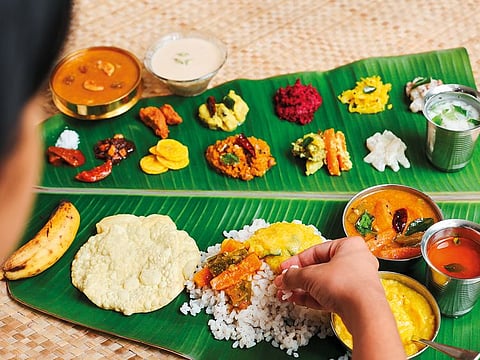Life lessons on a leaf
Kerala’s festive repast may feature just vegetarian fare, but serves up so much more

As an elaborate multi-course meal that is painstakingly prepared in Malayali homes around the world, it is a nod to tradition and an ode to timelessness. Dished up on a modest banana leaf but dressed up by surfeit, it is also a great equaliser that breaks through social creeds and religious convictions – it is emphatically inexpensive and accessible to all.
With its origins long forgotten but with originality still in play, and with multiplying numbers of fans, fanatics, purists and perfectionists, the Onasadya or traditional Onam feast stakes claim as Kerala’s best gift to the world.
Vegetable power and a powerhouse of customs, it unites people over food and festival, with flexible rules, rituals and rationales.
Tradition
While Kerala’s sadya or ceremonial feast is served on many occasions, the Onam edition differs, with preparation at home. Convenience stipulates that items such as jaggery-coated, deep-fried banana chips be store-bought, but true-blue Malayali families cook most of the meal themselves.
Entirely vegetarian, with rice as its hero, Onasadya celebrates Kerala’s monsoon harvest with an abundance of fresh produce that is steamed, simmered, stewed or sautéed – predominantly with the milk, cream and flesh of coconut. An unwritten rule demands a minimum of four accompanying dishes, but the final count always runs into double digits.
The leaf has a place and position for every dish, typically divided into four sections. The top half has enhancers and appetisers on the left and dry dishes on the right. The bottom half is reserved for rice and pouring dishes, while bananas and desserts are placed on its left. The large leaf is placed with its uncut end to the left of the guest.
Representation
Traditionally placed on a straw mat laid on the floor – but increasingly atop tables – Onasadya is served in panthi, batches of seated guests, and hosts seat themselves only after serving everyone else. Food is eaten with the right hand, without the use of cutlery, and cupped fingers often double up as ladles.
Rice is only served after guests are seated, and the pouring dishes are sequential: lentil with ghee, followed by sambar, pulissery or kalan, and ending with digestives such as rasam and buttermilk. The dessert, one or more payasams, can be eaten with rice, banana, pappadum or all three. The leaves are folded neatly when the meal ends.
Connection
Although traditionalists insist on cooking all dishes between dawn and 10am on the day of the meal, preparations begin earlier. Friends and family pitch in to cook but the guest list can be diverse and motley, especially in the UAE, where Onasadya brings together Arabs and Africans on the floors of Malayali homes, and draws Filipino fans to Kerala restaurants.

Rajnish Narayanan, who heads Brand Energy Digital’s offices in Toronto and Dubai, fondly recalls many editions. “Dubai is the best second home anyone from Kerala can wish for. With such a large Malayali community and everything easily available, Onam does not lose its grandeur on these foreign shores.”
He is also deeply nostalgic. “We have hosted many versions of Onasadya, and had very unusual guests. It is one of the most memorable parts of our long stay in Dubai.”
Nutrition
A treat for vegans, vegetarians and gluten-intolerants, even meat-eaters have no misgivings about this meal that is so different from their everyday diets.

“It is rich, diverse and complete,” says Roshan Nair, Sharjah resident and aspiring fitness consultant. “No one wants a morsel for hours after Onasadya, but they don’t realise how nutritious each dish is.” Take avial for instance, he explains, “Mixed vegetables steamed with fresh coconut and topped with yogurt, it is packed with nutrients and antioxidants.” He also praises another classic, the kootu curry, which uses chickpeas as a main ingredient. “Chickpeas are rich in protein and have a very low glycaemic index, making it ideal for diabetic, insulin-resistant, and fat-free diets.”
Fulfilment
The importance of the sadya is encapsulated in the Malayalam adage, Kaanam Vittum Onam Unnanam, roughly translated as: Eat Onasadya even if one’s property has to be sold.
Sisters-in-law Rona Manikath and Bindu Roby have been planning and preparing the family Onasadya for several years. “When we were kids, my grandmother adhered to the rigid Travancore Onasadya rules,” says Bindu. “She would frown on our shortcuts, but I think it evolves nicely. My children will do something different 15 years from now, but it will still be Onasadya.” New recipes and novelty foods include litchi pachadi, tofu avial, apple rasam, pineapple payasam and grape olan.
Rona speaks of fulfilment. “It is hard for many to imagine royal and vegetarian, or leaf and feast in the same breath, until they have experienced an Onasadya. One meal and they become believers. Vegetarian does not mean Spartan. Everyone eats as much as they want. It is a vegetable curry high,” she says.
“Onasadya is the taste of everything – sweet, sour, salty, tangy, bitter, burnt, pickled and preserved,” says Nair. “It is also all the good health you can get in a single meal.”
Sign up for the Daily Briefing
Get the latest news and updates straight to your inbox


